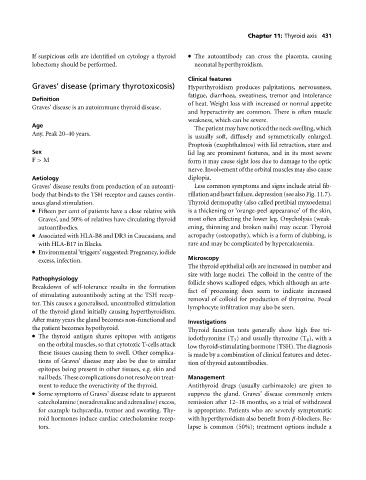Page 435 - Medicine and Surgery
P. 435
P1: FAW
BLUK007-11 BLUK007-Kendall May 25, 2005 8:5 Char Count= 0
Chapter 11: Thyroid axis 431
If suspicious cells are identified on cytology a thyroid The autoantibody can cross the placenta, causing
lobectomy should be performed. neonatal hyperthyroidism.
Clinical features
Graves’ disease (primary thyrotoxicosis) Hyperthyroidism produces palpitations, nervousness,
fatigue, diarrhoea, sweatiness, tremor and intolerance
Definition
of heat. Weight loss with increased or normal appetite
Graves’ disease is an autoimmune thyroid disease.
and hyperactivity are common. There is often muscle
weakness, which can be severe.
Age
The patient may have noticed the neck swelling, which
Any. Peak 20–40 years.
is usually soft, diffusely and symmetrically enlarged.
Proptosis (exophthalmos) with lid retraction, stare and
Sex lid lag are prominent features, and in its most severe
F > M form it may cause sight loss due to damage to the optic
nerve. Involvement of the orbital muscles may also cause
Aetiology diplopia.
Graves’ disease results from production of an autoanti- Less common symptoms and signs include atrial fib-
body that binds to the TSH receptor and causes contin- rillation and heart failure, depression (see also Fig. 11.7).
uous gland stimulation. Thyroid dermopathy (also called pretibial myxoedema)
Fifteen per cent of patients have a close relative with is a thickening or ‘orange-peel appearance’ of the skin,
Graves’, and 50% of relatives have circulating thyroid most often affecting the lower leg. Onycholysis (weak-
autoantibodies. ening, thinning and broken nails) may occur. Thyroid
Associated with HLA-B8 and DR3 in Caucasians, and acropachy (osteopathy), which is a form of clubbing, is
with HLA-B17 in Blacks. rare and may be complicated by hypercalcaemia.
Environmental ‘triggers’ suggested: Pregnancy, iodide
excess, infection. Microscopy
The thyroid epithelial cells are increased in number and
size with large nuclei. The colloid in the centre of the
Pathophysiology
follicle shows scalloped edges, which although an arte-
Breakdown of self-tolerance results in the formation
fact of processing does seem to indicate increased
of stimulating autoantibody acting at the TSH recep-
removal of colloid for production of thyroxine. Focal
tor. This causes a generalised, uncontrolled stimulation
lymphocyte infiltration may also be seen.
of the thyroid gland initially causing hyperthyroidism.
After many years the gland becomes non-functional and Investigations
the patient becomes hypothyroid. Thyroid function tests generally show high free tri-
The thyroid antigen shares epitopes with antigens iodothyronine (T 3 ) and usually thyroxine (T 4 ), with a
on the orbital muscles, so that cytotoxic T-cells attack low thyroid-stimulating hormone (TSH). The diagnosis
these tissues causing them to swell. Other complica- is made by a combination of clinical features and detec-
tions of Graves’ disease may also be due to similar tion of thyroid autoantibodies.
epitopes being present in other tissues, e.g. skin and
nailbeds.Thesecomplicationsdonotresolveontreat- Management
ment to reduce the overactivity of the thyroid. Antithyroid drugs (usually carbimazole) are given to
Some symptoms of Graves’ disease relate to apparent suppress the gland. Graves’ disease commonly enters
catecholamine (noradrenaline and adrenaline) excess, remission after 12–18 months, so a trial of withdrawal
for example tachycardia, tremor and sweating. Thy- is appropriate. Patients who are severely symptomatic
roid hormones induce cardiac catecholamine recep- with hyperthyroidism also benefit from β-blockers. Re-
tors. lapse is common (50%); treatment options include a

